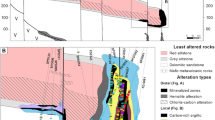Abstract
The Dungash historic gold mine is located in the South Eastern Desert of Egypt. The gold-bearing quartz veins are hosted by the metavolcanic and metavolcaniclastic rocks along an ENE–WSW trending shear zone. Alteration types recorded in the wall rocks are sericitization, silicification, carbonatization, chloritization, sulfidization, ferruginization, and listwanitization. The ore mineral assemblage comprises arsenopyrite, pyrite, native gold, pyrrhotite, sphalerite, chalcopyrite, and galena. The primary sulfide mineral assemblage formed during a hypogene hydrothermal stage whereas anglesite and goethite occur as secondary supergene phases. Microthermometric fluid inclusion analysis revealed that the auriferous quartz precipitated from a moderately saline (5 to 11.22 wt% NaClequiv) solution at temperatures above the recorded homogenization temperatures (T h), which range from 380 to 177 °C. The minimum pressures of trapping are between 350 and 400 bars. The fluid evolution during mineralization is explained by mixing of a magmatic fluid with meteoric waters. Initially, the high temperature and moderately saline magmatic fluid dominated and progressively became diluted with meteoric waters. Highest gold content is recorded in the carbonatized zone and the quartz veins. However, gold content in the carbonatized zone of the footwall exceeds several times its content in the quartz veins and the carbonatized zone of the hanging wall.








Similar content being viewed by others
References
Abdel-Tawab MM (1992) Gold exploration in Egypt from Pharaonic to modern times. Zb1 GeolPaleonTeilI 1:2721–2733
Ahmed SE (2012) Application of remote sensing techniques on gold mineralization and exploration at Dungash and Samut mines, South Eastern Desert, Egypt. M. Sc. Thesis, Cairo University
Brown PE (1989) FLINCOR: a microcomputer program for the reduction and investigation of fluid-inclusion data. Am Mineral 74(11–12):1390–1393
Groves DI, Goldfarb RJ, Gebre-Mariam M, Hagemann SG, Robert F (1998) Orogenic gold deposits: a proposed classification in the context of their crystal distribution and relationship to other gold deposits types. Ore Geol Rev 13:7–27
Hassaan MM (2006) Gold deposits in Egypt: a renewing resources for national income, The Ninth Arab Conference for mineral Resources, 30 Oct.., I. N. V. Jeddah, Kingdom of Saudi Arabia, Texts Book. 3: 45–42
Hassaan MM (2011) Metallic ore deposits of the Nubian Shield in Egypt: tectonic environs, geochemical behavior, promising sites. LAP LAMBERT Academic Publishing Gmb H & Co. KG and licensors, 256
Helba HA, Khalil IK, Abdou NM (2001) Alteration patterns related to hydrothermal gold mineralization in meta-andesites at Dungash area, Eastern Desert, Egypt. Resource Geo l51:19–30
Khalil KI, Helba HA, Mucke A (2003) Genesis of the gold mineralization at the Dungash gold mine area, Eastern Desert, Egypt: a mineralogical-microchemical study. J Afr Earth Sci 37:111–122
Kretschmar U, Scott SD (1976) Phase relations involving arsenopyrite in the system Fe–As–S and their application. Can Mineral 14:364–386
Liang Y (2015) The mineralization of the Woxi Au-Sb-W deposit, western Hunan, China. Graduate School of Science, Hiroshima University, Hiroshima
Liang Y, Hoshino K (2015) Thermodynamic calculations of AuxAg1-x—fluid equilibria and their applications for ore-forming conditions. Appl Geochem 52:109–117
Marten BE (1986) Reconnaissance of the gold deposits of the Eastern Desert of Egypt. Part I inter. Rep., no. 39/1986. Geol. Surv. Egypt, Cairo, Egypt. 101P
Morrison GW, Rose WJ, Jaireth S (1991) Geological and geochemical controls on the silver content (fineness) of gold in gold-silver deposits. Ore Geol Rev 6:333–364
Pal’yanova GA (2008) Physicochemical modeling of the coupled behavior of gold and silver in hydrothermal processes: gold fineness, Au/Ag ratios and their possible implications. Chem Geol 255:399–413
Pal’yanova GA, Kolonin GR (2007) Geochemical mobility of Au and Ag during hydrothermal transfer and precipitation: thermodynamic simulation. Geochem Int 45(8):744–757
Pal’yanova GA, Savva NE, Zhuravkova TV, Kolova EE (2016) Gold and silver minerals in low-sulfidaton ores of the Julietta deposit (northeastern Russia). Russ Geol Geophys 57:1171–1190
Roedder E (1984) Fluid inclusions. In Reviews in mineralogy (ed. P. H. Ribbe). Mineral Soc Amer 12: 644P
Schiffries CM (1990) Liquid–absent aqueous fluid inclusions and phase equilibria in the system CaCl2–NaCl–H2O. Geochemica et Cosmochemica Acta 54:611–619
Shikazono N, Shimizu M (1987) The Ag/Au ratio of native gold and electrum and the geochemical environment of gold vein deposits in Japan. Mineral Deposita 22:309–314
Takla MA (2001) Gold mineralization in Egypt: an overview. The Mineralogical Society, Egypt, The 14th Annual Meeting (abstract)
Zhang YG, Frantz JD (1987) Determination of the homogenization temperatures and densities of supercritical fluids in the system NaCl–KCl–CaCl2–H2O using synthetic fluid inclusions. Chem Geol 64(3):335–350
Zharikov VA, Rusinov VL (1998) Metasomatism and metasomatic rocks [in Russian]. Nauchnyi Mir, Moscow
Zoheir B, Weihed P (2014) Greenstone-hosted lode-gold mineralization at Dungash mine, Eastern Desert, Egypt. J Afr Earth Sci 99(1):165–187
Zoheir BA, El-Shazly AK, Helba H, Khalil KI, Bodnar RJ (2008) Origin and evolution of the Um Egat and Dungash orogenic gold deposits, Egyptian Eastern Desert: evidence from fluid inclusions in quartz. Econ Geol 103:405–424
Acknowledgements
We thank Prof. U. Schüßler for his help with electron microprobe analyses. Parts of this study were conducted at the University of Würzburg during a visit by Islam, A. D. Thanks also for the financial support from the DAAD.
Author information
Authors and Affiliations
Corresponding author
Rights and permissions
About this article
Cite this article
Dourgham, I.A., Fawzy, K.M. & Frimmel, H.E. Ore minerals and geochemical characterization of the Dungash gold deposit, South Eastern Desert, Egypt. Arab J Geosci 10, 145 (2017). https://doi.org/10.1007/s12517-017-2891-6
Received:
Accepted:
Published:
DOI: https://doi.org/10.1007/s12517-017-2891-6




